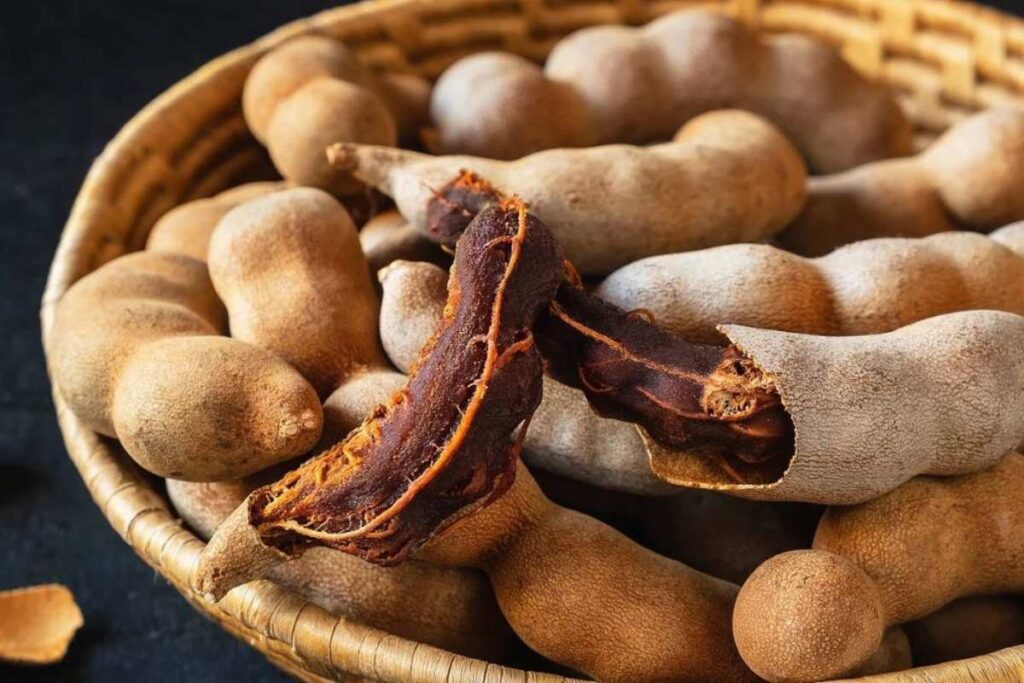Tamarind is a tropical fruit packed with antioxidants and fiber and has some anti-fungal, anti-bacterial, and anti-viral properties. People use it in all sorts of dishes from different parts of the world. It might even have some medicinal properties.
It can act as a blood thinner and help lower blood pressure. However, if someone is already taking blood-thinning medication, it’s a good idea to talk to a healthcare provider before adding tamarind to their diet.
This article covers everything you need to know about this fruit, how it can be good for your health if there are any risks, and even tips on how to use it.
Where is Tamarind Found?
Tamarind is a fruit of a tree found in Africa, India, Pakistan, and other tropical areas. The tamarind tree produces bean-like pods with seeds inside and a fibrous pulp surrounding them.

When the pods are young, the pulp is green and sour. But as they ripen, the pulp becomes juicy and more like a sweet-sour paste. Tamarind can sometimes referred to as the “date of India.” This fruit is quite versatile and can be used in various ways. It’s excellent for cooking, adding a delicious flavor to dishes. It also has health benefits and can be used for household purposes.
ALSO READ: These Foods Improve GLP-1 Levels in the Body
The Cooking Uses of Tamarind
Tamarind pulp is used mostly for cooking in South and Southeast Asia, Mexico, the Middle East, and the Caribbean.

People use it in several dishes to add a unique, tangy flavor. The seeds and leaves of the tamarind tree are also edible. Tamarind pulp is helpful in sauces, marinades, chutneys, drinks, and even desserts. It’s also a part of Worcestershire sauce.
Medicinal Uses of Tamarind
Tamarind drinks can be a go-to remedy for treating some health challenges. The bark and leaves were used to treat diarrhea, constipation, fever, and even malaria. They were also used to help wounds heal faster.
Modern researchers are now studying this plant for potential medicinal uses. Tamarind contains polyphenols, which have antioxidant and anti-inflammatory powers. These powers can help protect us from serious diseases like heart disease, cancer, and diabetes.
It is High in Nutrients
This fruit can be rich in nutrients. One cup (120 grams) of the pulp is packed with so much goodness. It has all sorts of vitamins and minerals that our bodies love. The fruit contains magnesium, which has 26% of the daily value (DV), potassium, 16% of the DV, and iron, 19% of the DV.
Furthermore, it contains Calcium: 7%, Phosphorus: 11%, Copper: 11%, Vitamin B1 (thiamin): 43%, Vitamin B2 (riboflavin): 14%, and Vitamin B3 (niacin): 15%. It has trace amounts of vitamin C, K, B6 (pyridoxine), folate, B5 (pantothenic acid), and selenium.
In addition, it contains six grams of fiber, three grams of protein, and less than one gram of fat, for a total of 287 calories. Tamarind has some sugar, but it is a natural sugar, not an added kind. So, even though it’s sweet, it’s still considered a fruit.
Added sugar is associated with metabolic syndrome and type 2 diabetes. The Dietary Guidelines for Americans suggest we cut back on it. The natural sugar found in fruits like tamarind is much better for us. It is like nature’s own sweet goodness.
This fruit also contains polyphenols, naturally occurring plant compounds with health benefits. Many of them act as antioxidants in the body.
ALSO READ: Can Fruits and Vegetables Prescription Improve Health?
The Fruit’s Antioxidants May Boost Heart Health
Tamarind fruit may help boost health in different ways. Its polyphenols and flavonoids can do wonders for cholesterol levels, helping to keep things in check and making our hearts happy.

A study of hamsters with high cholesterol found that tamarind fruit extract worked like magic. It lowered their total cholesterol, LDL (the bad cholesterol), and even those pesky triglycerides. Another animal study in vivo found that the antioxidants in this fruit can help reduce oxidative damage to LDL cholesterol, which is a crucial driver of heart disease.
How to Eat Tamarind
These fruits can be enjoyed in different ways. One is to eat the fruit from the raw pods simply. You can also use tamarind paste in cooking. You can prepare it from the pods or purchase it as a block.
The paste is often mixed with sugar to make candy. Tamarind can also be used to make condiments like chutney. Also, you can use the frozen, unsweetened pulp or sweetened tamarind syrup for cooking.
You Might Also Like:
What Are the Pros and Cons of a Pescatarian Diet?
Does Chlorophyll Have Any Health Benefits for the Body?
“Quite the Accomplishment,” Joe Biden Trolls Trump Over Golf Awards
Georgia DA Forges Ahead to Put Trump on Trial Before Election
